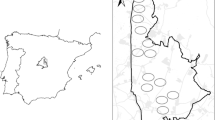Abstract
Predator-based repellents have been used experimentally to control wildlife damage in both agriculture and forestry, but they have not always been effective. We examined the relative importance of cover and predator odors in forage patch selection by Townsend's vole,Microtus townsendii, and its behavior related to cover and predator cues. Experiments were conducted in which forage patch and area choices were related to available habitat alternatives. Outdoor enclosures were divided into halves: one side was treated and the other used as a control. Treatments consisting of “cover,” “repellent,” and “cover plus repellent” were compared to controls (no cover, no repellent). In the absence of cover, voles preferred to feed on the side without repellents. When cover was present, voles preferred to feed on the side with cover, regardless of whether or not repellents were present. Voles visited more feeding stations on the side without cover when repellents and cover were present than they visited during cover-only treatments. These additional feeding stations, visited outside of cover, were used only lightly as food sources. The amounts of oats eaten by voles decreased with increasing distance from cover. This inverse relationship had a steeper slope in coveronly treatments compared to cover plus repellent treatments. A selection model based on forage patch selection and a habitat preference hierarchy is proposed. We conclude that predator odors are effective as repellents, but their efficacy depends on habitat conditions. Managers intending to use predator-based repellents must ensure that alternative sites available to pests are better quality habitat than in areas to be protected.
Similar content being viewed by others
References
Anderson, P.K. 1986. Foraging range in mice and voles: The role of risk.Can. J. Zool. 64:2645–2653.
Black, H.C., Dimock, E.J., Evans, J., andRochelle, J.A. 1979. Animal damage to coniferous plantations in Oregon and Washington. Part 1: A survey 1963-1975. Oregon State University Forest Research Laboratory, Research Bulletin 25. Corvallis, Oregon.
Campbell, D.L. 1974. Establishing preferred browse to reduce damage to douglas-fir seedlings by deer and elk. pp. 187–192,in H.C. Black (ed.). Proceedings, Symposium on Wildlife and Forest Management in the Pacific Northwest. Corvalis, Oregon.
Crouch, G.L. 1969. Animal damage to conifers in national forests in the Pacific Northwest region. U.S.D.A. Forestry Service Research Bulletin PNW-28.
Crump, D.R. 1978. 2-Propylthietane, the major malodorous substance from the anal gland of the stoat.Tetrahedron Lett. 1978:5233–5234.
Crump, D.R. 1980. Thietanes and dithiolanes from the anal gland of stoat (Mustela erminea).J. Chem. Ecol. 6:341–347.
Crump, D.R., andMoors, P.J. 1985. Anal gland secretions from the stoat (Mustela erminea) and the ferret (Mustelaputorius formafiiro): Some additional thietane components.J. Chem. Ecol. 11:1037–1043.
Fraser, D.F., andHuntingford, F.A. 1986. Feeding and avoiding predation hazard: The behavioural response of prey.Ethology 73:56–68.
Getz, L.L. 1985. Habitats, pp. 286–309,in R.H. Tamarin (ed.). Biology of New WorldMicrotus. Special Publication No. 8. The American Society of Mammalogists, Shippensburg, Pennsylvania.
Gorman, M.L. 1984. The response of prey to stoat (Mustela erminea) scent.J. Zool. London 202:419–423.
Harper, P.A., andHarestad, A.S. 1986. Vole damage to coniferous trees on Texada Island.For. Chron. 62:429–432.
Holmes, W.G. 1984. Predation risk and foraging behavior of the hoary marmot in Alaska.Behav. Ecol. Sociobiol. 15:293–301.
Krebs, J.R., andDavies, N.B. 1981. An Introduction to Behavioral Ecology. Blackwell Scientific Publications, Oxford, U.K.
Lima, S.L., andValone, T.J. 1986. Influence of predation risk on diet selection: A simple example in the grey squirrel.Anim. Behav. 34:536–544.
Lima, S.L., Valone, T.J., andCaraco, T. 1985. Foraging-efficiency-predation-risk trade-off in the grey squirrel.Anim. Behav. 33:155–165.
Maguire, C.C. 1989. Small mammal predation on Douglas-fir seedlings in northwestern California.Wildl. Soc. Bull 17:175–178.
Milinski, M., andHeller, R. 1978. Influence of a predator on the optimal foraging behaviour of sticklebacks (Gasterosteus aculeatus).Nature 275:642–644.
Rose, R.K., andBirney, E.C. 1985. Community ecology, pp. 310–339,in R.H. Tamarin (ed.). Biology of New WorldMicrotus. Special Publication No. 8. The American Society of Mammalogists.
Sih, A. 1980. Optimal behavior: Can foragers balance two conflicting demands?Science 210:1041–1043.
Sokal, R.R., andRohlf, F.J. 1981. Biometry, 2nd ed. W.H. Freeman, New York.
Stephens, M.A. 1982. Use of the von Mises distribution to analyze continuous proportions.Biometrika 69:197–203.
Stoddart, D.M. 1976. Effect of the odour of weasels (Mustela nivalis L.) on trapped samples of their prey.Oecologia 22:439–445.
Stoddart, D.M. 1980. Some responses of a free living community of rodents to the odours of predators, pp. 1–10,in D. Mueller-Schwarz and R.M. Silverstein (eds.). Chemical Signals: Vertebrates and Aquatic Invertebrates. Plenum Press, New York.
Sullivan, T.P. 1986. Influence of wolverine (Gulo gulo) odor on feeding behaviour of snowshoe hares (Lepus americanus).J. Mammal. 67:385–388.
Sullivan, T.P., andSullivan, D.S. 1982. Barking damage by snowshoe hares and red squirrels in lodgepole pine stands in central British Columbia.Can. J. For. Res. 12:443–448.
Sullivan, T.P., andSullivan, D.S. 1986. Impact of feeding damage by snowshoe hares on growth of juvenile lodgepole pine in central British Columbia.Can. J. For. Res. 16:1145–1149.
Sullivan, T.P., Nordstrom, L.O., andSullivan, D.S. 1985a Use of predator odors as repellents to reduce feeding damage by herbivores: I. Snowshoe hares (Lepus americanus).J. Chem. Ecol. 11:903–919.
Sullivan, T.P., Nordstrom, L.O., andSullivan, D.S. 1985b. Use of predator odors as repellents to reduce feeding damage by herbivores: II. Black-tailed deer (Odocoileus hemionus columbianus).J. Chem. Ecol. 11:921–935.
Sullivan, T.P., Crump, D.R., andSullivan, D.S. 1988a. Use of predator odors as repellents to reduce feeding damage by herbivores: III. montane and meadow voles (Microtus montanus and Microtus pennsylvanicus).J. Chem. Ecol. 14:363–377.
Sullivan, T.P., Crump, D.R., andSullivan, D.S. 1988b. Use of predator odors as repellents to reduce feeding damage by herbivores: IV. northern pocket gophers (Thomomys talpoides).J. Chem. Ecol. 14:379–389.
Taitt, M.J., Gipps, J.H.W., Krebs, C.J., andDundierski, J. 1981. The effect of extra food and cover on declining populations ofMicrotus townsendii.Can. J. Zool. 59:1593–1599.
Author information
Authors and Affiliations
Rights and permissions
About this article
Cite this article
Merkens, M., Harestad, A.S. & Sullivan, T.P. Cover and efficacy of predator-based repellents for Townsend's voleMicrotus townsendii . J Chem Ecol 17, 401–412 (1991). https://doi.org/10.1007/BF00994341
Received:
Accepted:
Issue Date:
DOI: https://doi.org/10.1007/BF00994341




